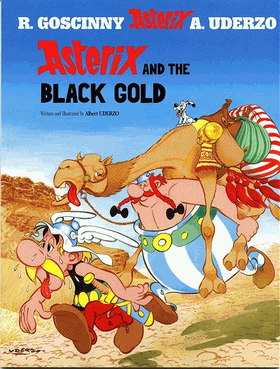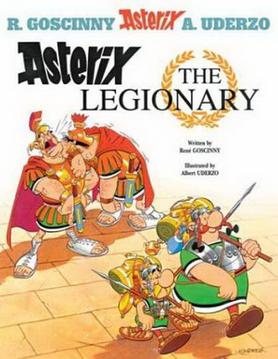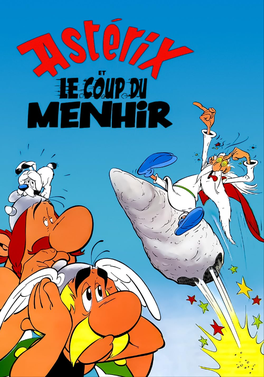
Asterix is a French comic album series about a Gaulish village which, thanks to a magic potion that enhances strength, resists the forces of Julius Caesar's Roman Republic Army in a nonhistorical telling of the time after the Gallic Wars. Many adventures take the titular hero Asterix and his friend Obelix to Rome and beyond.

Asterix and the Big Fight is a French comic book, the seventh in the Asterix comic book series. It was written by René Goscinny and illustrated by Albert Uderzo. Its original French title is Le Combat des chefs and it was first published in serial form in Pilote magazines, issues 261–302, in 1964. It was translated into English in 1971.

Asterix and the Golden Sickle is a French comic book story, written by René Goscinny and illustrated by Albert Uderzo, and published by Dargaud. It is the second story in the Asterix comic book series, and was originally published as a serial for Pilote magazine in 1960, before being re-released as a comic book in other languages.

Asterix and the Banquet is a French comic book story, written by René Goscinny and illustrated by Albert Uderzo, and published by Dargaud. It is the fifth story in the Asterix comic book series, and was originally published as a serial for Pilote magazine in 1963. The story focuses on Asterix and Obelix travelling around Gaul to find and secure various delicacies in order to win a bet against a Roman Prefect that seeks to keep their village isolated from the rest of the world.

Asterix and the Chieftain's Shield is the eleventh volume in the Asterix comic book series, written by René Goscinny and drawn by Albert Uderzo. It was originally published as a serial in Pilote issues 399–421 in 1967.

Asterix and the Black Gold is the twenty-sixth volume of Asterix comic book series, originally published in 1981. It is the second book to be both written and drawn by Albert Uderzo.

Asterix the Gladiator is a French comic book story, written by René Goscinny and illustrated by Albert Uderzo, and published by Dargaud. It is the fourth story in the Asterix comic book series, and was originally published as a serial for Pilote magazine in 1962. The story focuses on Asterix and Obelix heading to Rome to rescue their village's bard, culminating in them infiltrating the gladiatorial games to do so.

Asterix the Legionary is the tenth Asterix book in the Asterix comic book series by Rene Goscinny and Albert Uderzo. It was first published as a serial in Pilote magazine, issues 368–389, in 1966.

Asterix and the Normans is the ninth book in the Asterix comic book series, written by René Goscinny and drawn by Albert Uderzo. It was first published in serial form in Pilote magazine, issues 340–361, in 1966. It depicts a meeting between Asterix's Gaulish village and a ship full of Normans (Vikings).

Obelix and Co. is the twenty-third volume of the Asterix comic book series, by René Goscinny (stories) and Albert Uderzo (illustrations). The book's main focus is on the attempts by the Gaul-occupying Romans to corrupt the one remaining village that still holds out against them by instilling capitalism. It is also the penultimate volume written by Goscinny before his death in 1977; his final volume, Asterix in Belgium, was released after his death in 1979.

Asterix and the Soothsayer is the nineteenth volume of the Asterix comic book series, by René Goscinny (stories) and Albert Uderzo (illustrations). It was originally serialized in Pilote issues 652-673 in 1972.

Asterix in Switzerland is the sixteenth volume of the Asterix comic book series, by René Goscinny (stories) and Albert Uderzo (illustrations). It was originally serialized in Pilote magazine issues 557–578 in 1970 and translated into English in 1973.

Asterix and the Roman Agent is the fifteenth volume of the Asterix comic book series, by René Goscinny (stories) and Albert Uderzo (illustrations). It first appeared as a serial in Pilote magazine issues 531–552 in 1970 and was translated into English in 1972.

Asterix and the Actress is the 31st volume of the Asterix comic book series, written and illustrated by Albert Uderzo.

Asterix and the Falling Sky is the thirty-second volume of the Asterix comic book series, the ninth solely written and illustrated by Albert Uderzo and the only volume to introduce science fiction elements into the otherwise historical comedy series. The book was intended as a tribute to Walt Disney and a satire on the state of the French comics industry. It was released on October 14, 2005 to commercial success, but was panned by the critics. This was the final volume produced by Uderzo before handing over the series to a new creative team.

Asterix and the Big Fight is a 1989 French animated film directed by Philippe Grimond and produced by Yannick Piel. It is the film based on the Asterix comic series to being a co-production between France and Germany. Despite sharing the same title as Asterix and the Big Fight, the film shares only minor plot elements with that story, and is primarily an adaptation of Asterix and the Soothsayer. In the film, Getafix is accidentally made insane and amnesic by Obelix, forcing Asterix to try to cure him as his village is deceived by a fraudulent soothsayer that works for the Romans.

Asterix and the Picts is the 35th book in the Asterix series, and is the first book to be written by someone other than René Goscinny or Albert Uderzo. It was written by Jean-Yves Ferri and illustrated by Didier Conrad. The English-language version was translated by Anthea Bell.

Asterix and the Chieftain's Daughter is the 38th book in the Asterix series, and the fourth to be written by Jean-Yves Ferri and illustrated by Didier Conrad. The book was released worldwide in more than 20 languages on 24 October 2019 with an initial print run of over 5 million copies.


















